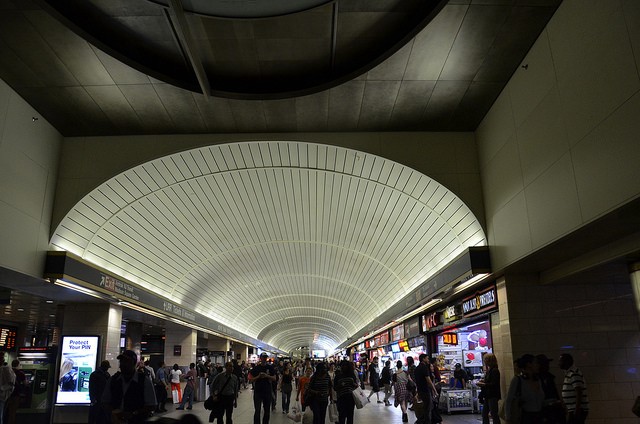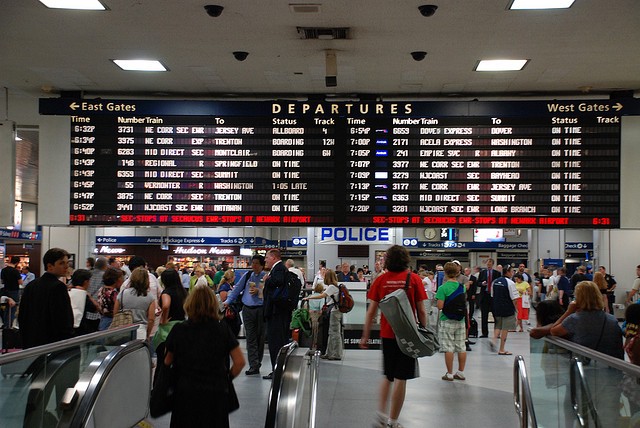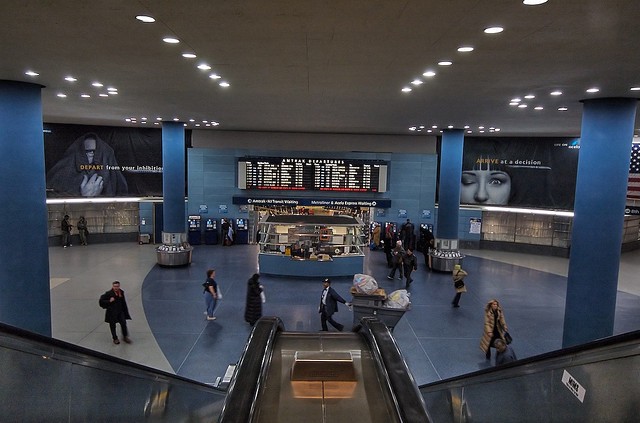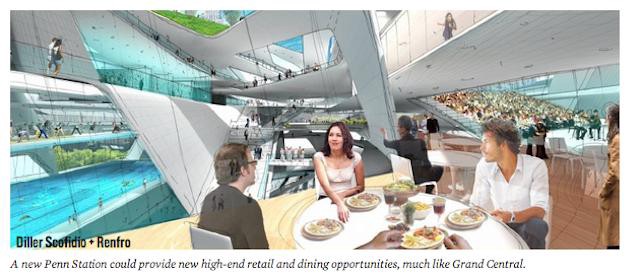A Walking Tour Through the Living Wreckage of Penn Station
A Walking Tour Through the Living Wreckage of Penn Station

Nearly everyone can agree that Penn Station, America’s busiest transit hub, which routinely takes in and spits out some five thousand humans every minute, is terrible in nearly every conceivable way. On a Wednesday in late March, David Lewis, a professor of cocnstructed environments at Parsons, and a partner at the architecture firm LTL (he’s one of the L’s), agreed to walk with me through Penn Station during rush-hour to show me not just how broken it was, but how it had become that way.
I was standing by the entrance on Penn’s southwest corner, at 31st Street and 8th Avenue, watching roadies haul equipment out of a semi-truck for a show that night, when Lewis walked up and introduced himself. “That’s part of your problem right there,” he said, pointing his finger at the semi, then up slightly toward at Madison Square Garden. “Getting as many people into a train station with a massive, twenty-thousand-seat multi-use performance space on top — it’s insane.”
In 1910, when the station first opened, there was a roof that soared fifteen stories above the tracks, and big, multi-story windows which let in oceans of sunlight. The roof and the windows came down in 1963, and now, five stories up from the tracks, which are three stories underground, there’s Madison Square Garden, which opened in its current form in 1968. The compressed space and complete lack of natural light make it hard to sense time; this is crucial to understanding its dysfunction, said Lewis, because a station, “any station, but no station more than a train station, is like a clock.” He corrected himself, “is a clock.”
As we descended into the first floor of Penn, in the Amtrak area, travelers brushed past. Lewis paused a moment. “The whole place is a corridor,” he said. “Why would you need high ceilings in a corridor?” he asked. I didn’t know, so he answered his own question. “This is the contradiction in the basic premise of the train station: Is it a point of destination where you want to come gather and hang out? Are you moving through to get out, or get in? Penn Station made the call, intentionally, that the spectacle was no longer financially viable. And, more importantly, you can get people in and out really efficiently.” People were moving, that’s for sure. We entered the stream of commuters marching toward Amtrak’s big boards and down to the platforms below. We passed a row of trashcans, above which hung photographs of the old station. In one, among the most iconic images of old Penn, light streamed in from high, holy-looking windows. Tiny travelers stood upon a marble floor, far below the rays of light. “No other train station in the world has photographs all over of the building they tore down!” Lewis said.

We walked north through the Amtrak waiting hall, past the passengers packed together by the boards, waiting for their train to be called. Then we entered an oblong almost-atrium. We faced north. To our left stood a sleek, glass and steel information booth. Hanging from its kiosk was a closed sign. The rest of the space was all but empty, too. “OK, we’re here,” said Lewis, “the center of the station.” He gestured east, toward a wide staircase to our right, descending from the street level. This, he said, used to be a carport, but it’s been closed to traffic for more than a decade. While I was looking at the staircase, Lewis pointed out that behind it was a long hallway that lead to Penn’s main entrance on Seventh Ave. I knew this corridor — it’s Penn’s main artery, and we were standing in what was meant to be a big finish, an opening at the end, a light at the terminus of a long and crowded tunnel. Only, you couldn’t see the hallway from here, and you couldn’t see the almost-atrium from the hallway, because the stairs blocked the view. A stairway to an unused carport made no sense today, but when the new Penn went up, a carport leading directly into the center of the station made all the sense in the world. It reminded me of something Stewart Brand wrote in his book, How Buildings Learn: “When we deal with buildings we deal with decisions taken long ago for remote reasons.”
The staircase wasn’t even the biggest problem here. “This was supposed to be your classic waiting room,” Lewis said, “But there’s no seating, and, where the hell are the trains?” I scanned the room. There wasn’t a lot of signage — mostly advertisements for Amtrak. And there was no direct passage to the tracks below. So the trains, once you could determine where they might be, were through another room — or, more accurately, three rooms: one for Amtrak, the station’s owner, another for New Jersey Transit, on the other side of the station, and one more, a floor below us, for the Long Island Railroad. Each waiting room for each rail line had an entirely different design — and even differently designed signage to get there. Ticketing, like the signage, is unique to each railway. A year ago, the former spokesman and operations planner for New York City transit wrote in the Times that the problem with Penn “is that territorial claims within the station run deep.”

This space had fallen victim to such claims, Lewis said. Penn Station had become “leftover.” It was “an empty center.” For some, this works. “It privileges those in the know,” was how Lewis put it. Surely this puts Penn in the running to be the most New Yorkish structure in all of New York. When you need to get Amtrak tickets, this is where you go, because no one is here, “and the people that are usually have no idea what they’re doing.” Lewis started toward the stairs, turning past and entering the main hall. Suddenly, we encountered a torrent of commuters, marching past the shops lining each side of the passage and off toward their tracks. We stood to one end, across from the Krispy Kreme. Lewis pointed out that nearly everything for sale was pushed way up to the front of each store — that’s where all the action was, and where all the customers were, moving, marching by. Some of the most successful businesses here, Lewis said, sell buckets of the same high-volume, low-cost, big-markup product iced down in barrels right out front: “Beer.” Then he added: “For the train ride ahead.” Almost no one lingers.

The problems facing Penn’s retail space are central to the station’s future, and the push to rebuild it. The Penn Station “submarket” (the ten-block area in and around Penn, from Tenth Avenue to the west, and Broadway to the east) has the lowest rental rates in Midtown Manhattan, according to a 2013 report by Cushman & Wakefield. Organizations calling to redevelop Penn, and its surroundings, have latched onto this fact, with an eye toward the transformation of Hudson Yards, the largest private real estate development in U.S. history. Last year, the Municipal Art Society of New York issued a big, splashy report titled “Unlocking Penn’s Potential,” which calls for a redevelopment of the neighborhood, citing economic opportunities of rezoning for larger public spaces and improved commercial, retail, and mixed use buildings. In the report, an image produced by the illustrious architecture firm Diller Scofidio + Renfro depicts a handsome trio dining fancily — their table looking out over several gleaming walkways, a sweeping central atrium, and a swimming pool. The caption is everything: “A new Penn Station could provide new high-end retail and dining opportunities, much like Grand Central.” The average rent in the Grand Central submarket is about twelve percent higher than Penn.
Money for a train station — even for the upkeep of an old, awful station, but especially the construction of a gleaming new one — normally comes from either ticket prices, which hit commuters, or from higher-end stores with increased rents, which hits commuters, sure, but mainly tourists. There is a third way, of course, and it’s sitting right on top of Penn. Madison Square Garden’s existence was not, Lewis said, the result of “some evil empire. The future of the train was in question. Other cities were bulldozing their stations. Something had to be done to generate enough money to keep Penn afloat.” That something was Madison Square Garden.
Today, Lewis continued, “in a bizarre conflation of nostalgia and futurism, we want our stations to harken back to the golden age of public transportation on fiscal budgets that don’t necessarily allow it.” The thing about these huge central atriums that Penn had and Grand Central has, though, is that while they are grand, they are also awkward, as in not efficient. “I would argue that Penn Station works extraordinarily well,” Lewis said. Better, in many ways, than Grand Central, where the main concourse is clogged with tourists taking pictures, interrupting the flow. Andrew Gelman, the director of the Applied Statistics Center at Columbia, argued much the same in a post on his personal blog, “In Praise of Penn Station”:
It’s easy to get around, there are lots of shortcuts, and the train loads fast–some people come down the escalators and elevators from the top level, others take the stairs from the middle level…[M]y guess is that the new Penn Station will be a lot more like an airport. Bright and airy, some top-end stores, it would look beautiful if it weren’t filled with thousands of people [some 750,000 each day] trying to get on and off the train in rush hour.
Lewis also wanted to show me how well Penn can work, so I followed him back to the Amtrak hall, then down a level, to a floor just above the tracks. “This is where you want to be!” he yelled over a very loud hum and strong breeze. We were standing in front of a large ventilation system, looking at small computer screens displaying the train schedules and track numbers. Around us were some business men and women with expensive commuter bags, looking bored. Lewis was saying something about Penn’s efficiencies, but it was tough to make out exactly what, over the noise. In Grand Central or Union Station in D.C., he shouted, there are many different thresholds to cross, grand halls to navigate, awestruck tourists to dodge, before one gets to the exact point of entry to the train. Not so at Penn. “Here you just slip in,” he said. “What?” I yelled. “YOU JUST SLIP IN!” he said. “The blowing is kind of annoying but that’s how you get air.”
As Lewis and I reemerged from the lower level, I pointed to Amtrak’s enclosed waiting area, one of the only places in Penn with a lot of seats. “I don’t even know what those people are doing in there,” Lewis said, and added that the sitting room was another example of the core problem facing a station, or really any public space that doubles as a transit hub. The people who use it the most, the commuters, wish to spend as little time there as possible; Penn is already mostly fine for them. It was rush hour now, and the commuters came streaming in, bunching around the big boards while others, the pros, ducked down into the loud and grimy platform below, closer to the tracks and eventual escape. Penn’s re-imaginings were for tourists; commuters just wanted to get home. Lewis grinned while he watched the efficiency of the space. Then we walked back up the stairs and stepped out into the glimmer and glow of the evening light.
Ryan Bradley is a writer and editor with a brand new electric car in a sunny land of children.
Photos by Peter Dutton, Andy Cross, and Peter Dutton
